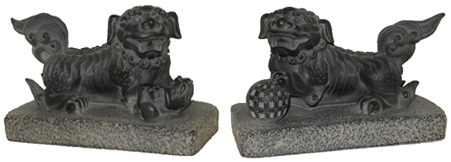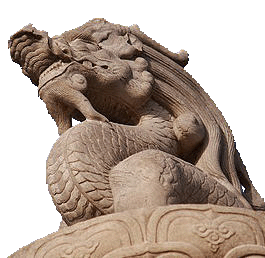The [tag]Cat[/tag], called [tag]Mao[/tag] (貓 māo)
[audio:mao1.mp3]
in Chinese, is said to have been given this name because of its mewing, but the composition of the written character, is to express an animal which catches rats in grain (Miao). Although the cat catches rats, it is loathe by the Chinese as being lazy as it sleeps most of the time. It is said that because of this lazy nature, it was not included as one of the twelve zodiac animals, being tricked and outwitted by the rat. Moreover, the coming of a cat into a household is an [tag]ill omen[/tag] of approaching poverty, as it is believed to foreshadow an unfavorable change in the pecuniary condition of the family as the cat can foresee where it will find plenty of rats and mice in consequence of approaching dilapidation of a house, following the ruin or poverty of its inhabitants.
The cat lacks fidelity and considered as being insincere so that a popular phrase used by the Chinese Maokulaoshu (貓哭老鼠 māo kū lǎo shǔ) the cat weeping over the mouse which it has just caught and eaten — an [tag]insincere[/tag] person. In addition a cat is believed to have demonic powers, and can see spirits in the dark, which it uses as a mouse-catcher. However, should a cat jump over a coffin, the corpses would be rise up and become an ‘undead’ to haunt the area. Therefore, a broom is always placed near the coffin so that if such occurrence should take place, the broom is thrown over the rising corpse to calm it and allowed to lie down dead again. For this reason, there is a custom that dead cats should not be buried lest they turn into mischievous spirits, therefore, they are hang up on trees.
It is said that the cat could tell time; at midnight, noon, sunrise, and sunset, the cat’s eye is like a thread. At 4 o’clock and 10 o’clock, morning and evening, it is round like a full moon. At 2 o’clock and 8 o’clock, morning and evening, it is elliptical like the kernel of a date.
The end of the nose is always cold, but for one day during the summer (Hsia-chih or summer solstice), it becomes warm, as the cat naturally dreads cold, but not heat.
As an [tag]auspicious symbol[/tag],the cat is found in two major depiction in wood block prints. One is called Canmaotu ([tag]蠶貓[/tag]圖 cán māo tú), the silkworm cat picture, which is placed on the door to the shed where silkworms are reared. The picture serves two purposes, one is that the cat would protect the silkworms from the rats and mice and secondly, it is a pictorial ‘Keep Out’ sign, of not disturbing the silkworms. This wood block print is also used as a paper votive during the sacrificial offering to the silkworm deity called, Matouniang (馬頭娘 mǎ tóu niáng) or Mamingwang (馬明王 mǎ míng wáng), at her temple or shrine called Canshenmiao (蠶神廟 cán shén miào)/
The second type of wood block print is called Maodietu (貓蝶圖 māo dié tú) which depicts a cat, butterfly and peony blossom. It is the symbolic forming of the rebus, Maodiefigui (耄耋富貴 mào dié fù guì) or longevity and prosperity. The term for a cat, Mao (貓 māo) is pronounced phonemically similar to the word Mao (耄 mào), meaning a person seventy or eighty years of age; and the term for a Butterfly, Die (蝶 dié), is pronounced phonemically similar to the word Die (耋 diè), a homonym for a person eighty or ninety years of age. Although the specific ages are sometimes mixed for the word Mao and Die, nevertheless, both refer to a person of great age and in turn means longevity.
Oftentimes, derogatory remarks include the use of the word for cat, such as Maoshutongmian (貓鼠同眠 māo shǔ tóng mián), literally, the cat and the rat are asleep together, meaning officials and bandits working in collusion. In the early Qing (清 qīng) dynasty, there were porcelain cats, made with eyes cut out so that a candle could be placed inside to scare off rats, a form of night light, and meticulously described in early Jesuit writings of Chinese ceramics.
The most popular and famous Chinese folktale of a cat is associated with the Rat’s Wedding, when the pretentious rat wanting to marry their daughter to someone great, dismissed the Sun, the clouds, the wind, the wall and opt for the cat, who made havoc of the wedding party and had a great meal of them.
Recently, the Chinese have adopted the Japanese ‘beckoning cat’ called Mani nekko in Japanese and renamed as Zhaocaimao (招財貓 zhāo cái māo), meaning inviting wealth cat, by the Chinese, as a good luck symbol for business establishments. However, being unsure of which paw should be raised, the Chinese have made alterations, of having either a right or left paw, and also having the figurine of the cat made with two faces, a front and a back so that the cat could have either a right or left paw raised.
It should be pointed out, that inasmuch as the Mani Nekko is a late-Tokugawa period Japanese folk art, the Japanese themselves are confused as to which paw should be raised, moreover, to the different colors of the cat. In addition, the Chinese have added various other inscriptions to the cat, which then appears like a Japanese version but with a Chinese flavor. There are so many variations and so often seen in Chinese establishments, that many believe it to be Chinese instead of an adapted version of something Japanese.
-By William C. Hu and David Lei
Ponddy Reader Lessons:
HSK Level 1: 早上好 – Good Morning
HSK Level 3: 接机 – Picking up someone at the airport
HSK Level 4: 动物园一日游 – A day in the Zoo



 It resembles a dragon but is not a dragon, nor is it claimed to be one of the nine descendants of the dragon.
It resembles a dragon but is not a dragon, nor is it claimed to be one of the nine descendants of the dragon.